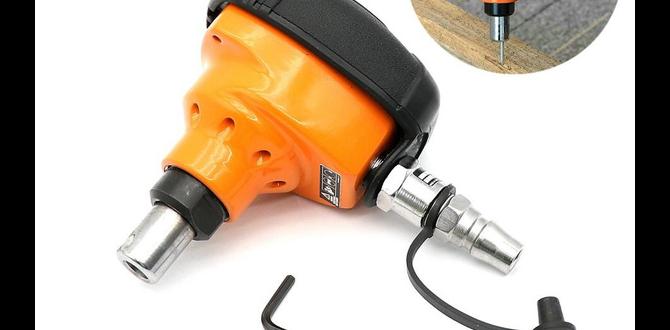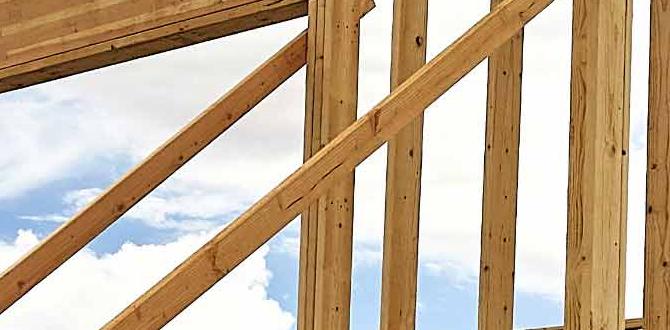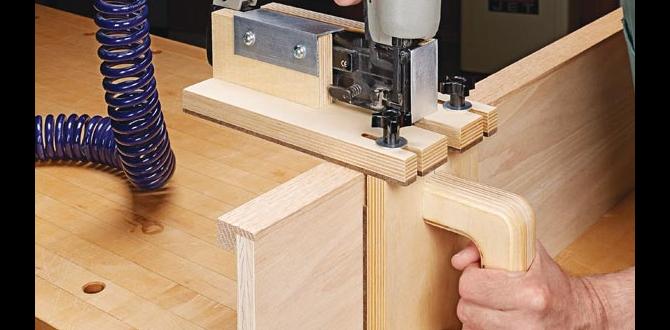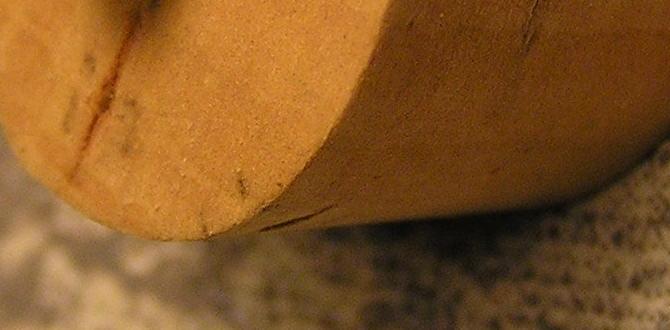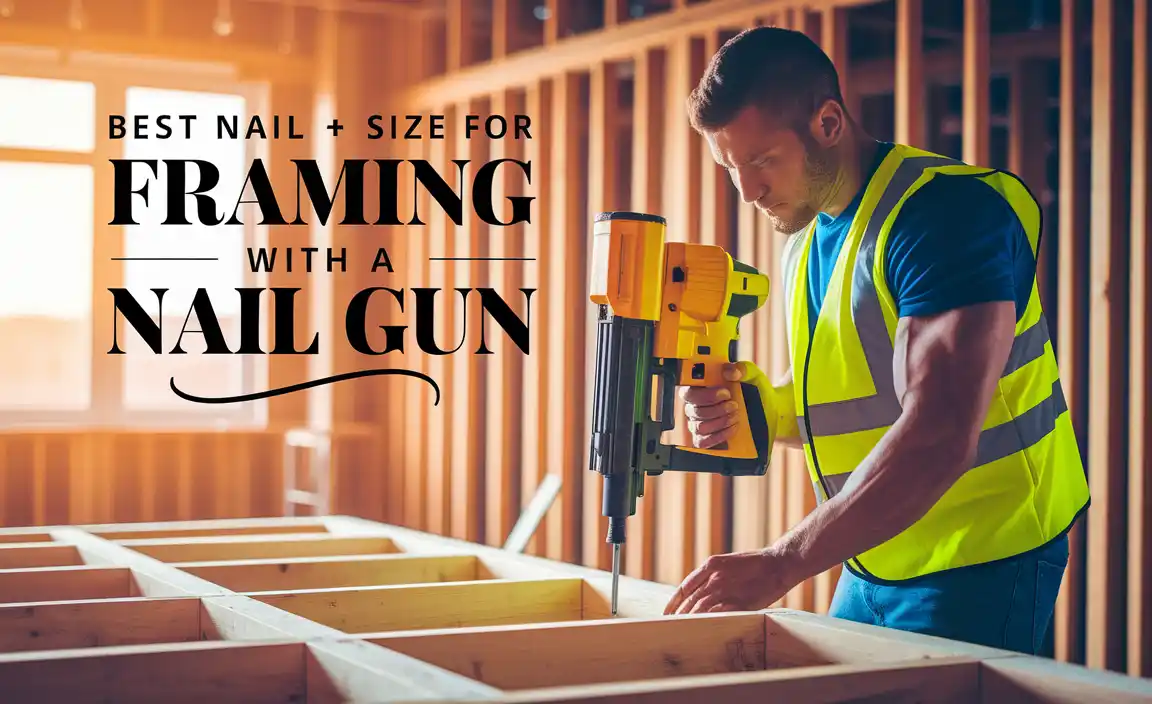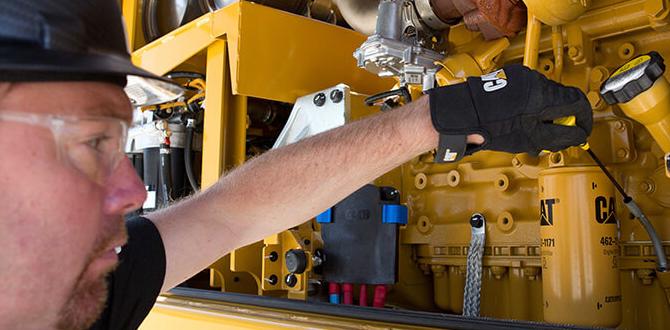Have you ever wondered how those powerful nail guns work? They’re handy tools that make building things much quicker and easier. But did you know that each nail gun has specific psi requirements? Psi stands for pounds per square inch, and it tells you how much air pressure the nail gun needs to operate properly.
Imagine trying to fix a fence without the right pressure. You might end up with crooked nails or even damaged wood. That’s why understanding nail gun psi requirements is so important!
In this article, we will explore what psi means for nail guns. We’ll discuss why it matters and how to choose the right pressure for your projects. With the right information, you can tackle any building task with confidence and skill. Ready to dive in? Let’s get started!
Table of Contents
Nail Gun Psi Requirements: Understanding Optimal Pressure Levels

Nail Gun PSI Requirements
Understanding nail gun PSI requirements is essential for efficient use. You might wonder, what is PSI? It stands for pounds per square inch, a measure of air pressure. Different nail guns need different PSI levels to work properly. For example, a framing nail gun often requires 70-110 PSI, while a brad nailer may need just 60-80 PSI. Using the wrong PSI can lead to misfired nails or even damage. It’s surprising how much the right pressure affects your project’s outcome! So, always check the specifications before starting your work.Understanding Nail Gun PSI
Definition of PSI and its significance in nail guns. Explanation of how PSI relates to nail gun performance.PSI stands for pounds per square inch. It measures the pressure used by nail guns. The right PSI is vital for how well a nail gun works. If the PSI is too low, nails may not go in deep enough. If it’s too high, the nails can miss the mark. Knowing the right PSI helps your projects be safe and successful.
How does PSI affect nail gun performance?
PSI directly affects how well your nail gun drives nails. A higher PSI means more force. This can lead to better performance. But if you use too high a PSI, it can damage materials. So, it’s key to find the right balance.
Factors Influencing PSI Requirements
Material being nailed (wood, metal, etc.). Size and type of nails used.Many things affect the psi requirements of a nail gun. The main factors are the material being nailed and the type of nails used. Different materials need different power levels. For example:
- Wood: Softer woods need lower psi.
- Metal: Thicker metals require higher psi for effective nailing.
The size of the nails also plays a big role. Larger nails need more force. If the nails are too small, using high psi can cause damage. So, it’s important to choose the right tool for the job.
What does “psi” mean in nail guns?
Psi stands for “pounds per square inch.” It measures how much pressure the nail gun applies when firing nails.
How to Choose the Right Compressor for Your Nail Gun
Key specifications to consider (CFM, tank size, PSI). Recommendations for matching nail guns with appropriate compressors.Choosing the right compressor for a nail gun is important for getting great results. Three key specifications to look for are CFM, tank size, and PSI. Here’s a quick guide:
- CFM (Cubic Feet per Minute): This measures how much air the compressor can deliver. Nail guns need at least 2-4 CFM.
- Tank Size: A larger tank holds more air. Look for a tank size of 2 gallons or more for steady use.
- PSI (Pounds per Square Inch): This shows air pressure. Most nail guns need between 70-120 PSI.
Match your nail gun carefully. For instance, a framing nail gun works well with a compressor that has a higher PSI and CFM. Always check these numbers to avoid problems while working.
What are the key specs for matching nail guns with compressors?
CFM, tank size, and PSI are the key specs needed for a good match. A well-matched compressor can help your nail gun work better and longer.
Common Mistakes and Misconceptions About Nail Gun PSI
Overinflation and its consequences. Misunderstanding the effects of low PSI on performance.Nail guns are handy, but let’s avoid some common goofs! First, overinflating your nail gun can lead to chaos. Too much pressure might send nails flying where they shouldn’t be. Ouch! This can also damage the tool, making it a pricey paperweight.
On the flip side, low PSI doesn’t mean you’re not doing great. Some folks think they need killer pressure for strong performance. That’s a myth! Nail guns can still work wonders at lower levels. A hefty PSI isn’t always a hero—sometimes, it’s just a noisy villain!
| Pressure Level | Potential Problem |
|---|---|
| Overinflated | Missed hits and possible damage. |
| Low PSI | Inconsistent nail depth and performance. |
Safety Considerations Related to PSI Levels
Importance of proper PSI for safe operation. Tips for maintaining safety while using nail guns.Using a nail gun can be fun, but it must be safe too! Proper PSI levels are super important. Too high, and you might turn your nail gun into a mini rocket launcher, and we don’t want that! Keep your PSI within the recommended range. Always wear safety glasses and ear protection. Avoid distractions; those can lead to accidents faster than a speeding nail!
| Safety Tips | Details |
|---|---|
| Wear Protective Gear | Always wear safety glasses and ear protection. |
| Check PSI | Ensure the PSI is within the manufacturer’s range. |
| Avoid Distractions | Stay focused while using the tool! |
Maintenance Tips for Nail Guns and Compressors
Regular maintenance practices to ensure optimal PSI levels. Troubleshooting common PSIrelated issues.To keep your nail gun and compressor happy, they need regular TLC! Check the oil levels and clean the filters often. This helps keep optimal PSI levels. If you notice that your nail gun is making weird noises or the pressure is low, it might be time for a quick check-up. Common issues can often be fixed easily, like clearing a clogged nozzle or adjusting the pressure settings. Your tools will thank you with every nail they fire!
| Maintenance Tip | Frequency |
|---|---|
| Check oil levels | Weekly |
| Clean filters | Monthly |
| Inspect hoses | Every use |
FAQs on Nail Gun PSI Requirements
Addressing common queries and concerns. Providing expert advice on specific scenarios.Nail guns can be tricky if you’re unsure about the right pressure. Here are some common questions you might have about nail gun psi requirements:
What is the right PSI for my nail gun?
The proper PSI often depends on the type of nails you use. For framing, it’s usually between 70-120 PSI. For finish nails, you may use 60-100 PSI.
Can I use my nail gun at a lower PSI?
Yes, you can! Lower PSI can help prevent damage to softer materials but may cause nails to stick out. Always test first on scrap wood.
What happens if I use too high PSI?
Using too high PSI can cause nails to sink too deep or even break the material. Always adjust according to the task.
Be mindful of these tips to ensure safe and effective use of your nail gun!
Conclusion
In conclusion, understanding nail gun PSI requirements is crucial for safe and effective use. Different tasks need different pressures. For softer materials, lower PSI works; for harder surfaces, you’ll need more. Always check your nail gun’s manual for exact numbers. Now that you know, you’re ready to choose the right settings. Feel free to read more about nail gun safety tips!FAQs
What Is The Typical Psi Range Required For Different Types Of Nail Guns (E.G., Pneumatic, Electric, Cordless)?Different nail guns need different air pressure to work well. For a pneumatic nail gun, you usually need 70 to 120 PSI (pounds per square inch). Electric nail guns don’t need air but use electricity instead. Cordless nail guns rely on batteries and also don’t use air. So, you only need to worry about PSI for pneumatic nail guns!
How Does The Psi Requirement Vary Between Finishing Nail Guns And Framing Nail Guns?Finishing nail guns need less power than framing nail guns. They usually work best with around 70 to 100 PSI (pounds per square inch). Framing nail guns need more power, often around 90 to 120 PSI. This extra power helps them drive bigger nails into thick wood. So, finishing nail guns are lighter and easier to use, while framing nail guns are stronger for heavy-duty work.
What Factors Can Influence The Optimal Psi Setting For A Nail Gun In Specific Applications?The best PSI (pounds per square inch) setting for a nail gun can change based on what you’re doing. If you’re using hard wood, you need a higher PSI to drive the nails in. For softer wood, a lower PSI works better. The size of the nails also matters; bigger nails might need more power. Always check the job you’re doing to choose the right setting!
How Can Incorrect Psi Settings Affect The Performance And Safety Of A Nail Gun?If the PSI (pounds per square inch) is set too high, the nail gun can shoot nails too fast. This can make it harder to control and can cause injuries. If the PSI is too low, the nails might not go in properly, which can make your project weak. Always check the settings to keep working safely and getting good results!
What Steps Should Be Taken To Properly Adjust And Maintain The Psi Levels Of A Nail Gun?To adjust the PSI (pounds per square inch) for your nail gun, first, check your user manual for the right PSI setting. Use a pressure gauge to see the current PSI. If it’s too high or low, turn the pressure adjustment knob until it matches the recommended level. Always check the PSI before using it. Also, keep your nail gun clean and lubricated for better performance.
{“@context”:”https://schema.org”,”@type”: “FAQPage”,”mainEntity”:[{“@type”: “Question”,”name”: “What Is The Typical Psi Range Required For Different Types Of Nail Guns (E.G., Pneumatic, Electric, Cordless)? “,”acceptedAnswer”: {“@type”: “Answer”,”text”: “Different nail guns need different air pressure to work well. For a pneumatic nail gun, you usually need 70 to 120 PSI (pounds per square inch). Electric nail guns don’t need air but use electricity instead. Cordless nail guns rely on batteries and also don’t use air. So, you only need to worry about PSI for pneumatic nail guns!”}},{“@type”: “Question”,”name”: “How Does The Psi Requirement Vary Between Finishing Nail Guns And Framing Nail Guns? “,”acceptedAnswer”: {“@type”: “Answer”,”text”: “Finishing nail guns need less power than framing nail guns. They usually work best with around 70 to 100 PSI (pounds per square inch). Framing nail guns need more power, often around 90 to 120 PSI. This extra power helps them drive bigger nails into thick wood. So, finishing nail guns are lighter and easier to use, while framing nail guns are stronger for heavy-duty work.”}},{“@type”: “Question”,”name”: “What Factors Can Influence The Optimal Psi Setting For A Nail Gun In Specific Applications? “,”acceptedAnswer”: {“@type”: “Answer”,”text”: “The best PSI (pounds per square inch) setting for a nail gun can change based on what you’re doing. If you’re using hard wood, you need a higher PSI to drive the nails in. For softer wood, a lower PSI works better. The size of the nails also matters; bigger nails might need more power. Always check the job you’re doing to choose the right setting!”}},{“@type”: “Question”,”name”: “How Can Incorrect Psi Settings Affect The Performance And Safety Of A Nail Gun? “,”acceptedAnswer”: {“@type”: “Answer”,”text”: “If the PSI (pounds per square inch) is set too high, the nail gun can shoot nails too fast. This can make it harder to control and can cause injuries. If the PSI is too low, the nails might not go in properly, which can make your project weak. Always check the settings to keep working safely and getting good results!”}},{“@type”: “Question”,”name”: “What Steps Should Be Taken To Properly Adjust And Maintain The Psi Levels Of A Nail Gun? “,”acceptedAnswer”: {“@type”: “Answer”,”text”: “To adjust the PSI (pounds per square inch) for your nail gun, first, check your user manual for the right PSI setting. Use a pressure gauge to see the current PSI. If it’s too high or low, turn the pressure adjustment knob until it matches the recommended level. Always check the PSI before using it. Also, keep your nail gun clean and lubricated for better performance.”}}]}